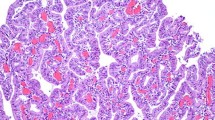Summary
Weekly s. c. injections of 21 mg 1,2-dimethylhydrazine/kg body weight induced in rats papillomas and carcinomas of the small and large intestine. In 12 of a total of 77 rats adenocarcinomas arose in the large intestine between the 10th and 16 th week after starting the injections. In the same groups 3 carcinomas and 21 papillomas of the small intestine were detected histologically.
Autoradiographic investigations after application of 34S-sulphate and 3H-thymidine showed between the 5th and 12 th weeks alterations of the mucosa of the large intestine characterized by a decrease in the number of mucous secreting cells. The differentiation of basal epithelial cells to mucous secreting cells was inhibited. In the same regions the number of DNA synthesizing cells increased, producing an enlargement of the proliferation zone which reached from the bottom of the crypts up to the surface of the mucosa. The labelling index increased 3 fold compared to the normal. Also in the small intestine the “indifferenzzone”, being normally identical with the crypts of Lieberkühn, extended the length of the villi. The epithelial cells of the tips of the villi showed a high proliferating activity. Papillomas developed in those areas closely related to the proliferation activity of the epithelia. As in the large intestine the areas with enlarged proliferation zones showed a loss of cellular differentiation.
Zusammenfassung
Den nach wöchentlicher Applikation von 1,2-Diemthylhydrazin im Dünn- und Dickdarm der Ratte sich entwickelnden Carcinomen sind Veränderungen an der Schleimhaut vorgeschaltet, die durch eine Entdifferenzierung und Proliferationssteigerung charakterisiert sind. Im Autoradiogramm finden sich dabei nach Applikation von 3-H-Thymidin in der Dickdarmschleimhaut Herde, in denen bei völligem Fehlen der Becherzellen die Proliferationszone bis an die Schleimhautoberfläche heranreicht. Im Dünndarm verbreitert sich die Indifferenzzone über die gesamte Zotte hinweg. Vor allem die Veränderungen am Dickdarm sind in jeder Beziehung denen ähnlich, die man bei der Schleimhautregeneration beobachtet.
Similar content being viewed by others
Literatur
Arenz, F., Oehlert, W.: Die Regeneration der Dickdarmschleimhaut der Ratte nach Lokal- und Ganzkörperbestrahlung. Strahlentherapie 138, 365–374 (1969).
Druckrey, H., Preussmann, R., Matzkies, F., Ivankovic, S.: Erzeugung von Darmkrebs bei Ratten durch 1,2-Diemthylhydrazin. Naturwissenschaften 54, 385–286 (1967).
Eder, M.: Neuere morphologische Aspekte der Magen-Darm-Tumoren. Fortschritte der Krebsforschung. Stuttgart-New York: Schattauer, 1969.
Huber, P.: Histophysiologische Untersuchungen am Darmepithel der weißen Maus mit Delphinin. Vjschr. naturforsch. Ges. Zürich 90, Beiheft 4, 1–88 (1945).
Schauer, A., Völlnagel, Th., Wildanger, F.: Cancerisierung des Rattendarmes durch 1,2-Dimethylhydrazin. Z. ges. exp. Med. 150, 87–93 (1969).
Thomas, C.: Pers. Mitteilung 1970.
Author information
Authors and Affiliations
Rights and permissions
About this article
Cite this article
Springer, P., Springer, J. & Oehlert, W. Die Vorstufen des 1,2-Dimethylhydrazin-induzierten Dick- und Dünndarmcarcinoms der Ratte. Z Krebs-forsch 74, 236–240 (1970). https://doi.org/10.1007/BF00525456
Received:
Issue Date:
DOI: https://doi.org/10.1007/BF00525456



